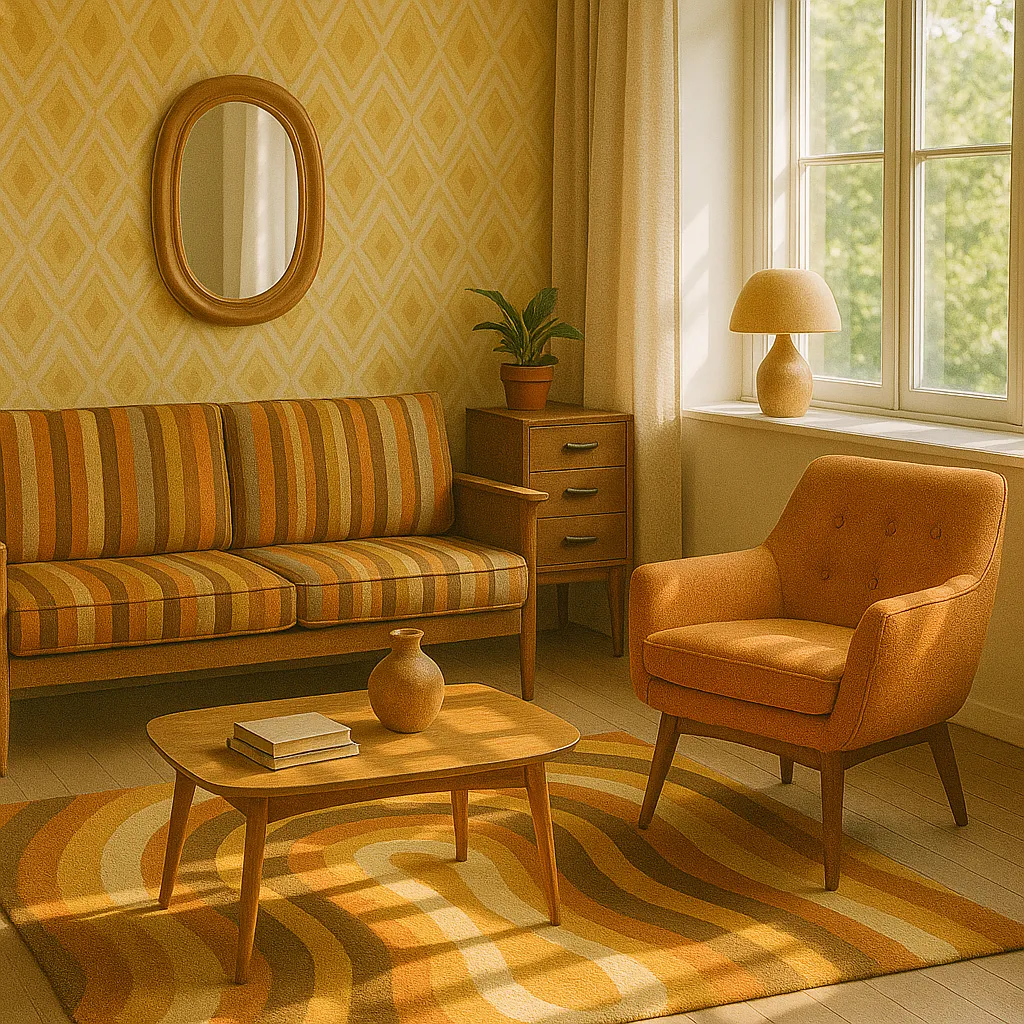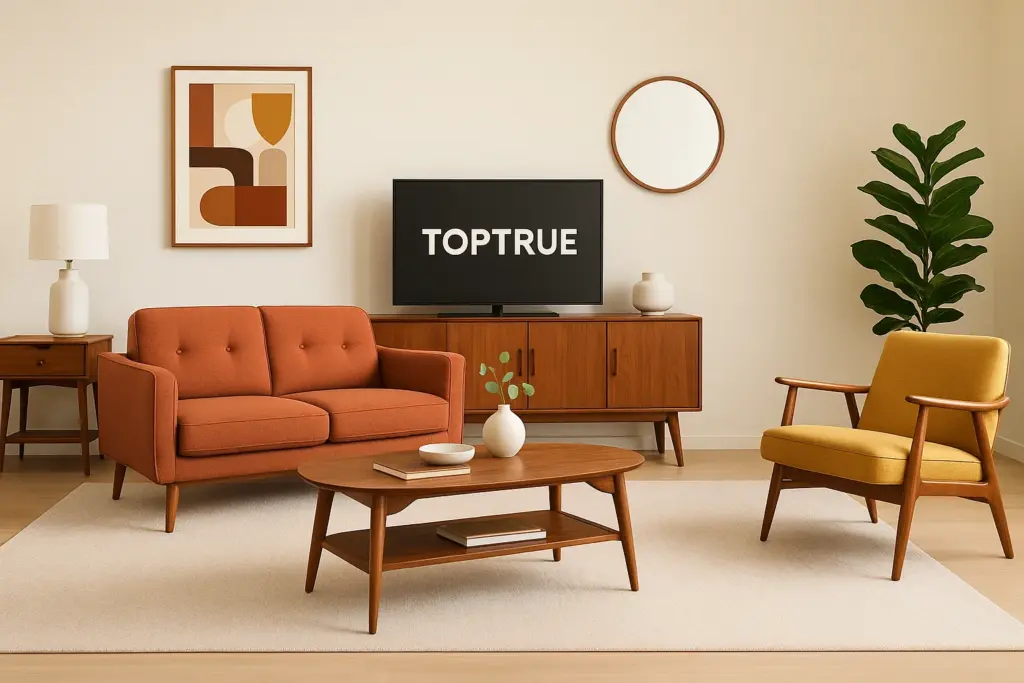In the ever-flowing river of time, home design styles shimmer like brilliant stars, constantly shifting in their glow. The 1970s, without a doubt, stand out as a period brimming with unique charm—aesthetic styles from that era are like a melodic old song, whose lingering notes still echo and captivate today.
During that time, warm earthy tones felt like a gentle embrace from the earth itself, playful curves outlined the liveliness and joy of life, and rich textures told stories etched by time. The design of the ’70s infused living spaces with unprecedented personality and comfort, turning homes into true sanctuaries for the soul.
Today, the retro trend is quietly surging like an undercurrent in the field of interior design, ready to rise to the surface. It is not a mere replica of the past, but a heartfelt return to warmth, simplicity, and individuality. On this journey of revival, we have the opportunity to seamlessly integrate the essence of the 1970s into modern interiors—allowing nostalgia and contemporary flair to collide in a burst of brilliance, and creating spaces that carry the memories of the past while showcasing the refinement of the present. Next, let us explore how to embark on this journey through time and design.

Curves and playful silhouettes: graceful dancers in the space
In the ’70s, people adored graceful curves. Furniture featured soft, rounded shapes, like dancers moving through the room—an oval coffee table reminiscent of a smooth pebble, a barrel-back chair offering a cozy embrace, an arched mirror that seems to open a secret portal, and sculptural light fixtures that serve as art pieces. These forms soften the room and draw the eye with their invisible allure.
Today’s retro-inspired design refines these shapes with modern simplicity—sleek, curved lounge chairs retain vintage charm while fitting minimalist lifestyles; kidney-shaped tables with tapered legs become functional focal points. These pieces serve as elegant ambassadors, merging nostalgia with modern minimalism.
Wood as a design staple: timeless elegance
Natural wood—walnut, teak, and oak—formed the backbone of ’70s decor, adding depth, texture, and enduring elegance. Walnut’s fine grains and deep tones speak of sophistication; teak’s golden warmth lends stability; oak’s clear grain and honest simplicity tell a story of nature. Mid-century modern furniture, with clean lines and tapered legs, echoes the ’70s aesthetic while fitting seamlessly into modern homes.
Consider investing in a wood veneer sideboard—a treasure chest of stories. Opening its doors reveals a glossy flashback to the ’70s. Or place a wooden coffee table in the living room—the heart of family gatherings. A media console, wooden-framed mirror, or lamp with a wooden base also evoke warm retro vibes through subtle accents.
Textures: understated statements of character
Another hallmark of ’70s style was texture. Corduroy’s softness feels like a mother’s gentle caress; velvet’s smoothness glides like silk; boucle’s earthiness offers comfort; ceramic’s lustrous warmth conveys artisanal charm; shag rugs feel cloud-like underfoot. Today, texture remains essential, but used subtly to add contrast and depth rather than visual clutter.
Try mixing materials—wooden table paired with a velvet armchair to balance rustic and plush tones. Lay a soft rug under sleek-legged furniture to create layers. Textured pillows or ceramic vases can introduce depth and warmth in a modern elegant setting.
Minimalist retro accents: the finishing touches
Retro styling doesn’t require a full renovation—sometimes, carefully chosen accents are all it takes. Warm-tone abstract wall art adds artistic flair; sculptural lamps become functional artworks; retro-style clocks evoke nostalgic charm; ceramic planters bring life to the room.
Round mirrors and geometric or color-block art are particularly eye-catching. A round mirror acts like a soft glowing moon; geometric art features clean lines and modern edge; color-block pieces inject energy. Hunting for vintage or antique items at thrift or antique stores can yield unique treasures that add character and history.
Nostalgic lighting: the mood-maker
Lighting defines any room’s tone. Retro lighting often uses warm bulbs, globe shapes, or ceramic and brass bases. Warm bulbs offer a winter-sun feel; globes add playful roundness; ceramic and brass bases convey elegance. These fixtures harmonize beautifully with soft furnishings and retro color palettes.
Mushroom-shaped table lamps add fun charm; smoked-glass pendant lights bring mystery, invoking a ’70s evening. Choose warm white bulbs instead of cool-toned ones to immerse your space in comfort.
Fusion: a harmonious medley of old and new
The key to ’70s style in modern homes is intentional contrast. Blending old and new elements thoughtfully creates a harmonious symphony—each piece contributing its role. Use retro elements to add warmth and visual interest to sleek, modern environments—but don’t overdo it, as too many retro pieces may seem costume-like and detract from the contemporary feel.
Here are some tips to achieve this fusion:
- Stick to a consistent palette with one or two signature retro hues to maintain harmony.
- Choose one or two standout pieces and design the rest around them to center the room.
- Use neutral tones and open space to balance bold colors or patterns.
- Incorporate modern lighting and accessories to ensure the room feels current yet cohesive.
- Layer textures and shapes thoughtfully to create a lively, inviting space, where every detail charms.

Conclusion
Retro design is more than a trend—it’s a celebration of timeless style and comfort. By drawing inspiration from the 1970s and applying a modern lens, we can create homes that feel both vintage and contemporary. These spaces are like thick historical volumes and melodic songs—each page and note alive with past brilliance and modern vigor. Let us embrace this retro-inspired journey, feel the flow of time, and savor the beauty of life.

